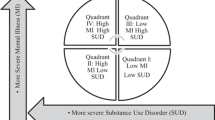Abstract
Numerous bureaus of mental health, drug addiction, and alcoholism are designated to provide service to persons who have discrete singular disorders of mental illness, drug addiction, or alcoholism. Mental health and substance abuse programs (nationally and internationally) have evolved with this singular limited-service capacity. Contrasting incompatible philosophies and treatment methods across the systems have resulted in minimal services for persons with dual diagnoses. The project the authors have outlined is an example of the development of a dual/multiple-disorder program that integrates these diverse systems and provides comprehensive services within each of the programs of each delivery system. These programs are cost-effective, use existing facilities, train and cross-train existing staff, correct the issues of incompatible treatment interventions, and end the dilemma of gaps in services systems and limited referral resources. As a result, the availability and quality of care for persons with dual diagnoses is greatly improved.
Similar content being viewed by others
References
The Multiple Dilemmas of the Multiply Disabled: An Approach to Improving Services for the Mentally Ill Chemical Abuser. Albany: New York State Commission on Quality of Care for the Mentally Disabled, 1986.
Ridgely MS, Osher FC, Talbott JA:Chronic Mentally Ill Young Adults With Substance Abuse Problems: Treatment and Training Issues, Baltimore: University of Maryland, School of Medicine, Mental Health Policy Studies, 1987.
Center for Vulnerable Populations: Drugs, drinking and us: A costly combination for people and policy.Spotlight 1993; 29(18).
Federal Task Force on Homelessness and Severe Mental Illness:Outcasts on Main Street., Washington, DC: U.S. Department of Health and Human Services, 1992.
Minkoff K, Drake R: Dual diagnosis of major mental illness and substance disorder: An overview. In: Minkoff K, Drake R (Eds.):Dual Diagnosis of Major Mental Illness and Substance Disorder (New Directions for Mental Health Services, No. 50). San Francisco: Jossey-Bass, 1991, pp. 1–2.
Ridgely MS, Goldman HH, Willenbring M: Barriers to the care of persons with dual diagnosis: Organizational and financing issues.Schizophrenia Bulletin 1990; 16(1):123–132.
Sciacca K: An integrated treatment approach for severely mentally ill individuals with substance disorders. In: Minkoff K, Drake R (Eds.):Dual Diagnosis of Major Mental Illness and Substance Disorder (New Directions for Mental Health Services, No. 50). San Francisco: Jossey-Bass, 1991, pp. 69–84.
Sciacca K: Alcohol and substance abuse programs at New York State psychiatric centers develop and expand.Addiction Intervention With the Disabled Bulletin (Winter, 1987), pp. 1–3.
Mental Health Code, Act 258, of the Public Act of 1974: Public laws enacted by the legislature of the state of Michigan, compiled laws.
Mental Health Code, Act 358, of the Public Act of 1974: Public laws enacted by the legislature of the state of Michigan, compiled laws.
Schlick C, Smith K: Alcohol and Drug Consults. Unpublished manuscript, Department of Counseling Psychology, Western Michigan University, 1992.
Sciacca K: New initiatives in the treatment of the chronic patient with alcohol substance use problems.TIE Lines (July, 1987), pp. 5–6. (Information Exchange on Young Adult Chronic Patients, Inc.)
Sciacca K:MIDAA Service Manual: A Step by Step Guide to Program Implementation for Multiple Disorders. New York: Sciacca Comprehensive Service Development for MIDAA, 1990.
Beard J, Propst R, Malamud T: The Fountainhouse model of psychiatric rehabilitation.Psychosocial Rehabilitation Journal 1982; 5(1):47–53.
Stein LI, Test MA: Alternative to mental hospital treatment: I. Conceptual model, treatment program, and clinical evaluation.Archives of General Psychiatry 1980; 37:392–397.
Diagnostic and Statistical Manual of Mental Disorders-III-R. Third ed., rev. Washington, DC: American Psychiatric Association, 1987.
Diagnostic and Statistical Manual of Mental Disorders-IV. Fourth ed. Washington, DC: American Psychiatric Association, 1994.
Mayfield D, McCleod G, Hall P: The CAGE Questionnaire: Validation of a new alcoholism screening instrument.American Journal of Psychiatry 1974; 131:1121–1123.
Sciacca K, Hatfield AB: The family and the dually diagnosed patient. In: Lehaman AF, Dixon LB (Eds.):Double Jeopardy: Chronic Mental Illness and Substance Disorders. Chur, Switzerland: Harwood Academic, 1995, chap. 12, pp. 193–209.
Author information
Authors and Affiliations
Additional information
The “MIDAA” (Mental Illness, Drug Addiction, and Alcoholism) acronym and logo are registered trademarks of Kathleen Sciacca and Sciacca Comprehensive Service Development for MIDAA.
Rights and permissions
About this article
Cite this article
Sciacca, K., Thompson, C.M. Program development and integrated treatment across systems for dual diagnosis: Mental illness, drug addiction, and alcoholism (MIDAA). The Journal of Mental Health Administration 23, 288–297 (1996). https://doi.org/10.1007/BF02522303
Issue Date:
DOI: https://doi.org/10.1007/BF02522303




